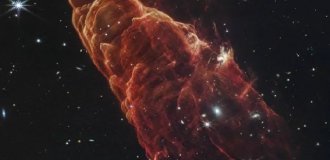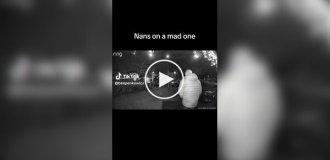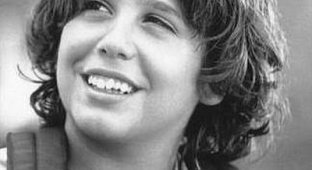The story of the Muse Brothers: kidnapping, a circus of freaks and returning home (15 photos)
This heartbreaking but gripping story unfolds in... early 20th century in the USA. Its main characters are two African Americans, developmentally delayed albino brothers George and Willie Muse, who childhood, cunning circus entrepreneurs kidnapped from the family and forced perform in a circus of freaks. 
George and Willie Muse's life changed dramatically when they taken from a farm in Virginia and thrown into the bright lights of the circus world. Their history is a story of uniqueness, exploitation and ultimately liberation.
George and Willie Muse, the eldest of five siblings, were born to Harriet Muse in the small village of Truvine on the outskirts of Roanoke, Virginia 
They were born with albinism, a genetic disorder giving them pale skin, white hair and bright blue eyes. The boys were very different from their peers. Both brothers also had nystagmus (tremor of the eyeballs) is a common phenomenon in albinism, affecting vision. Their struggle with photosensitivity began like this It's too early that by the age of six and nine years boys already have marks on their foreheads. permanent wrinkles.
The Muse Brothers: Willie (left) and George with showman Al Barnes, 1918–22. 
Like their neighbors, the Muse family made a living tobacco sharecropping. The boys had a clear future ahead of them - they would helped their family in the field, protecting tobacco plants from pests and eliminating potential threats before they can cause harm precious harvest.
Harriett Muse cared for her sons as best she could, but The family's life was very poor and difficult. Besides the grueling physical labor, we should not forget that this is a black family, and boys are black children with albinism, that is, even more vulnerable to discrimination and abuse.
In 1899, six-year-old George and his nine-year-old brother Willie came to the attention of a "freak hunter" named James Herman "Candy" Shelton. Shelton was looking for "freaks" for the circus who could compare in popularity with such famous artists as Siamese twins from Thailand known as Chang and Eng, or the dwarf brothers from Ohio, whom circus showman P.T. Barnum nicknamed "The Wild Men" Borneo."
"Cool Photo" 1924, Ringling Bros. Circus and Barnum and Bailey. George Muse is third from left in the top row; Willie —third from the right 
It is believed that George and Willie's parents initially agreed allow the boys to take part in several performances with Shelton Circus in Truvine in 1899 to earn some extra money this. However, no one planned to let them go on tour with the circus. Shelton, unable to reach an agreement, simply kidnapped the albino brothers when his circus was leaving the village. The boys were in the field, Shelton lured them sweets and took them with him. 
At the beginning of the 20th century, the touring circus was one of the main entertainment for ordinary Americans. Along with the usual circus acts special performances and shows were also very popular freaks - with demonstration of unique talents or unique physical features. Shelton saw greatness in black albinos potential to make good money.
The brothers were given the circus names Eko and Iko, and since then their lives have been took place exclusively at a freak show. They were promoted under different legends - “monkey people”, “white Ecuadorian cannibals”, “envoys from Mars", "people with sheep's heads" and so on.
Eco and Iko in a promotional photo 
This is how their childhood, youth, and growing up period passed. They do did not go to school and did not learn to read and write. They weren't paid for their work not a penny. They were told that their mother had died so that they could not even think about returning home. did not arise.
One day, a circus photographer gave the Muse brothers a banjo and guitar - after they posed for him with these instruments for photographs. At first their manager thought it was a joke because I believed that the brothers knew how to play music. But it turned out that George and Willie had a special talent - they could learn to play almost any melody.
Although George was only three years older, he became a defender Willie spoke for both of them. George spoke and Willie expressed himself in mainly through music. During the Firstth world war they found solace in the popular song "It's a Long Way to Tipperary". They sang about how homesick they are.
"Messengers from Mars?" 
The years passed, and the brothers' appearance underwent dramatic changes. changes. They were dressed in bright suits, and their hair was styled in unique dreadlocks that looked like fireworks exploding on his head.
On large banners they were called "Messengers from Mars" and "Men with sheep's heads." Legends about their origin have been given out from case by case, they were found on a raft near Madagascar, then in the Mojave Desert...
As showman Al J. Barnes recalled in his 1936 memoirs year: “There was a story that the boys were members of a sheephead colony people who inhabited an island in the South Seas; that they were caught after many terrible escapes and that they were the only specimens in captivity. The boys had a very low level of intelligence, and the story the press agent was a great fit for them.”
Eco and Iko with their circus colleagues 
In October 1927, when the circus moved into Roanoke, the brothers Muse was advertised as Messengers from Mars. According to the story, Eko and Iko were discovered in 1923 when they crawled out of a hole near the wreckage spaceship in the Mojave Desert.
The idea that these supposed Martians are playing popular tunes next to a circus tent in Virginia, could seem completely pointless, but that didn't stop the crowds curious people gather to see them.
George and Willie Muse in the earliest known circus photograph 
On that fall day at the Roanoke fairgrounds, while George played the mandolin and Willie played the guitar, their attention attracted something remarkable: a black woman managed to break through forward among a predominantly white audience.
“There’s our dear old mother,” exclaimed George. “Look, Willie, she’s not dead.”
They quickly put down their tools and rushed to hug the woman they had not seen for many years.
During this period, Harriett Muse worked as a maid and laundress in Roanoke. Despite her illiteracy, she somehow learned that her sons are coming to town. And now, after all these years, brothers reunited with their mother.
Harriett Muse (right), her husband Cabell (far left) with by the Muse Brothers shortly after she found them at the circus performance in 1927 
The press became interested in the story of the Muse brothers, and public opinion overwhelmingly supported the desire mothers to get justice. The case attracted widespread attention. In 1927 The court finally ruled in favor of Harriett Muse. This is the solution was a turning point in the lives of George and Willie.
They were freed from the clutches of the circus and allowed to return to their family, who never gave up hope of seeing them again.
Harriett Muse was known in the family as the woman with the iron a will that protected its sons and fought for their return 
Life after the circus was not without difficulties. George and Willie had to reacquaint himself with the world they were from separated for more than two decades. They encountered curiosity and sometimes with prejudice because of his unique appearance.
It soon became clear that they were too accustomed to circus life and it is already difficult for them to rebuild. In 1928, the Muse brothers returned to the circus world, but on their own terms.
Their performances took place in a variety of places, from Buckingham Palace to Hawaii, where they shared the stage with sword swallowers, giants and even some actors who later will appear as Munchkins in The Wizard of Oz.
By the end of the 1920s, the Muse brothers became one of the circus stars, the kind that newspapers write about and whose performances attract crowds of people. 
George and Willie were already earning very well, and they sent part of the mother's earnings. With this money Harriett Muse bought a small farm and gradually climbed out of poverty. After her death in 1942 the sale of this farm gave the Muse brothers the opportunity to move into a house in Roanoke, where they spent the rest of their lives. Somewhere before the mid 50s they still performed from time to time, then retired.
George Mewes died in 1972 due to heart disease.Ouch insufficiency, and Willie lived until 2001, achieving remarkable age - 111 years. 

Eco and Ico, sheep-headed cannibals from Ecuador. To be believable, they had to growl on stage and eat raw meat 
























